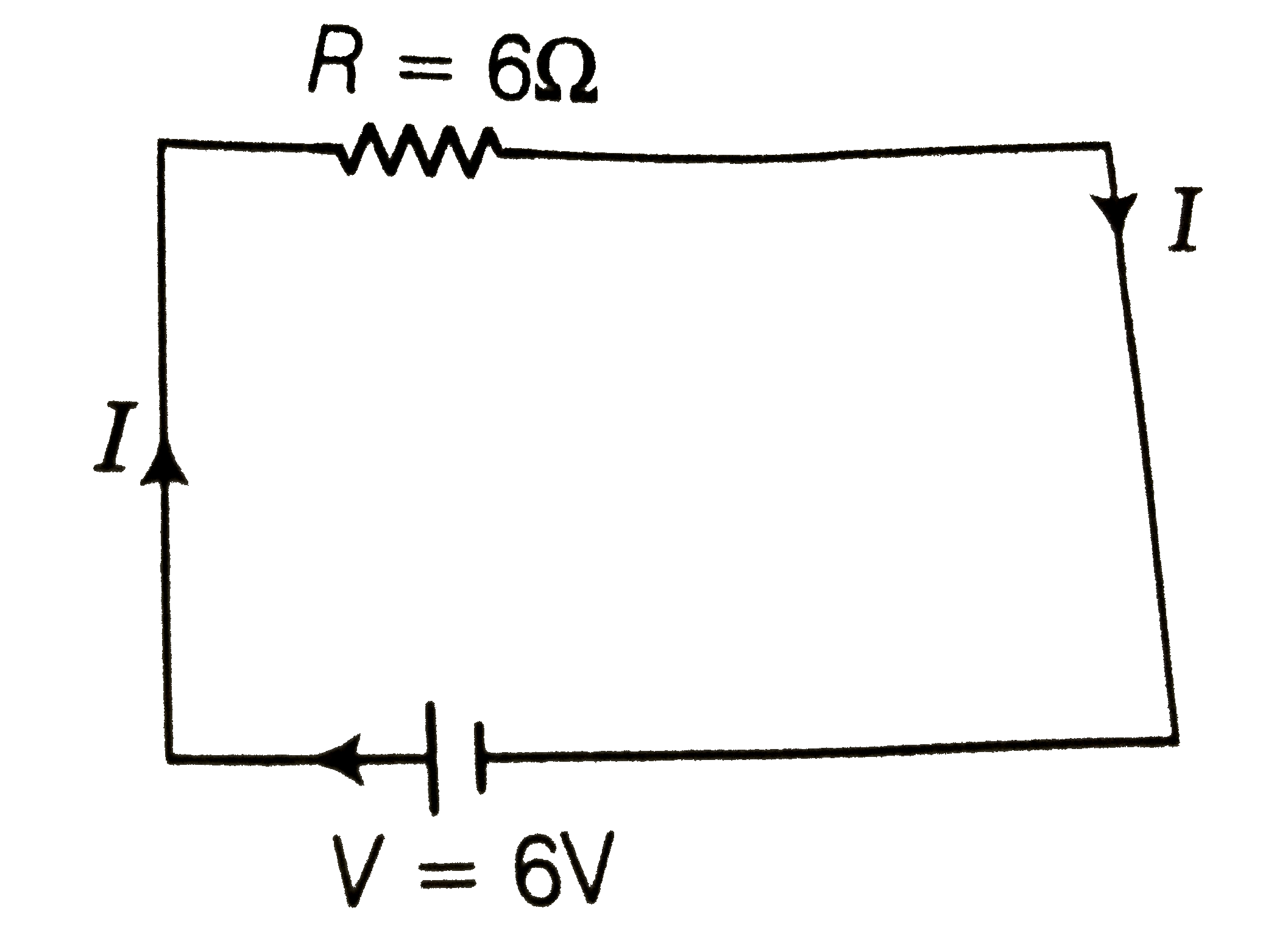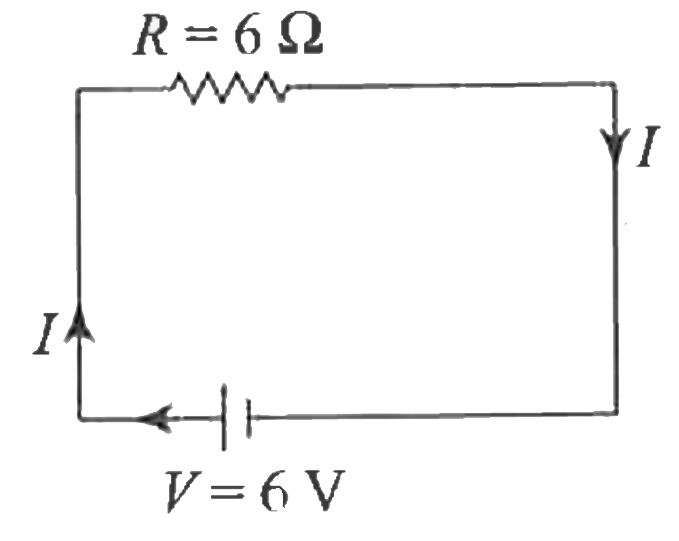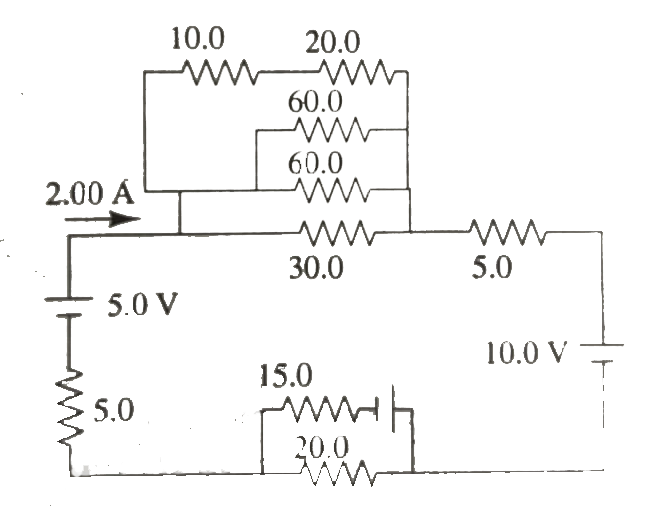
(a). Consider circuit in figure. How much energy is absorbed by electrons from the initial state of no current (ignore thermal motion) to the state of drift velocity?
(b). Electrons give up energy at the rate of RI2 per second to the thermal energy. what time scale would number associate with energy in problem (a)? n=number f electron/volume=1029/m3. Length of circuit =10cm, cross-section=A=(1mm)2.
(a). By ohm's law, current I is given by
I=6V/6Ω=1A
But, InetAvd
or vd=ineA
On substituting the values
For, n=number of electron/volume =1029/m3
Length of cirucit=10cm, cross-section =A=(1mm)2
vd=11029×1.6×10−19×10−6
=11.6×10−4m/s
Therefore, the energy absorbed int he form of KE is given by
KE=12mev2d×nAI
=12×9.1×1031×12.56×1020×108×106×101
=2×10−17J
(b). Power loss is given by P=I2R=6×12=6W=6J/s
Since, P=Et
Therefore, E=P×t
or t=EP=2×10−176=10−17s
Topper's Solved these Questions
- CURRENT ELECTRICITYBook:NCERT EXEMPLAR ENGLISHChapter:CURRENT ELECTRICITYExercise:MCQs (More than one options)
Explore 5 Videos
- COMMUNICATION SYSTEMBook:NCERT EXEMPLAR ENGLISHChapter:COMMUNICATION SYSTEMExercise:LONG ANSWER TYPE QUESTIONS
Explore 5 Videos
- DUAL NATURE OF RADIATION AND MATTERBook:NCERT EXEMPLAR ENGLISHChapter:DUAL NATURE OF RADIATION AND MATTERExercise:LONG ANSWER TYPE QUESTION
Explore 5 Videos
Similar Questions
Consider the circuit in the figure.

(a) how much energy is absorbed by electrons from the initial state of no current (ignore thermal motion) to the state of drift velocity?
(b) Electrons give up energy at the rate of Rl2 per second to the thermal energy. What time scale would the number associate with energy in problem (a)? n = number of electron/volume =1029/m3. Length of circuit = 10cm cross-section = A=(1mm)2.
View SolutionA conductor wire having 1029 free electrons /m3 carries a current of 20A. If the cross-section of the wire is 1mm2, then the drift velocity of electrons will be :
View SolutionThere are 8.4×1022 free electrons per cm3 in copper. The current in the wire is 0.21A (e=1.6×10−19C). Then the drifts velocity of electrns in a copper wire of 1mm2 cross section, will be:-
View SolutionWhat is the energy in eV requried to excite the electron from n=1 to n=2 state in hydrogen atom? (n=principal quantum number)
View SolutionThe energy, radius and velocity of the electron in the hydrogen atom in the ground state are −13.6eV,0.53Å and 2.188×108ms−1 respectively.
The energy of the electron in the third orbit will be
View SolutionWhat is the energy in joules required to shift the electron of the hydrogen atom from the first Bohr orbit to the fifth Bohr orbit ? And what is the wavelength of the light emitted when the electron returns to the ground state ? The ground state electron energy is −218×10−11 erg.
View SolutionWhat is the energy in joules required to shift the electron of the hydrogen atom from the first Bohr orbit to the fifth Bohr orbit ? And what is the wavelength of the light emitted when the electron returns to the ground state ? The ground state electron energy is −218×10−11 erg.
View SolutionIn the circuit shown in Fig 7.25,
(a) what must the emfε of the battery be in order for a current of 2.00A to flow through the 5.00V battery , as shown ? Is the polarity of the battery shown is correct?
b. How long does it take for 60.0J of thermal energy to be produced in the 10.0Ωresistor?

View SolutionCalculate the drift speed of the electrons when 1A of current exists in a copper wire of cross section 2 mm2.The number of free electrons in 1cm3of copper is 8.5×1022.
View SolutionAn electron in a hydrogen atom in its ground state absorbs 1.5 times as much energy as the minimum required for it to escape from the atom. What is the velocity of the emitted electron?
View Solution

